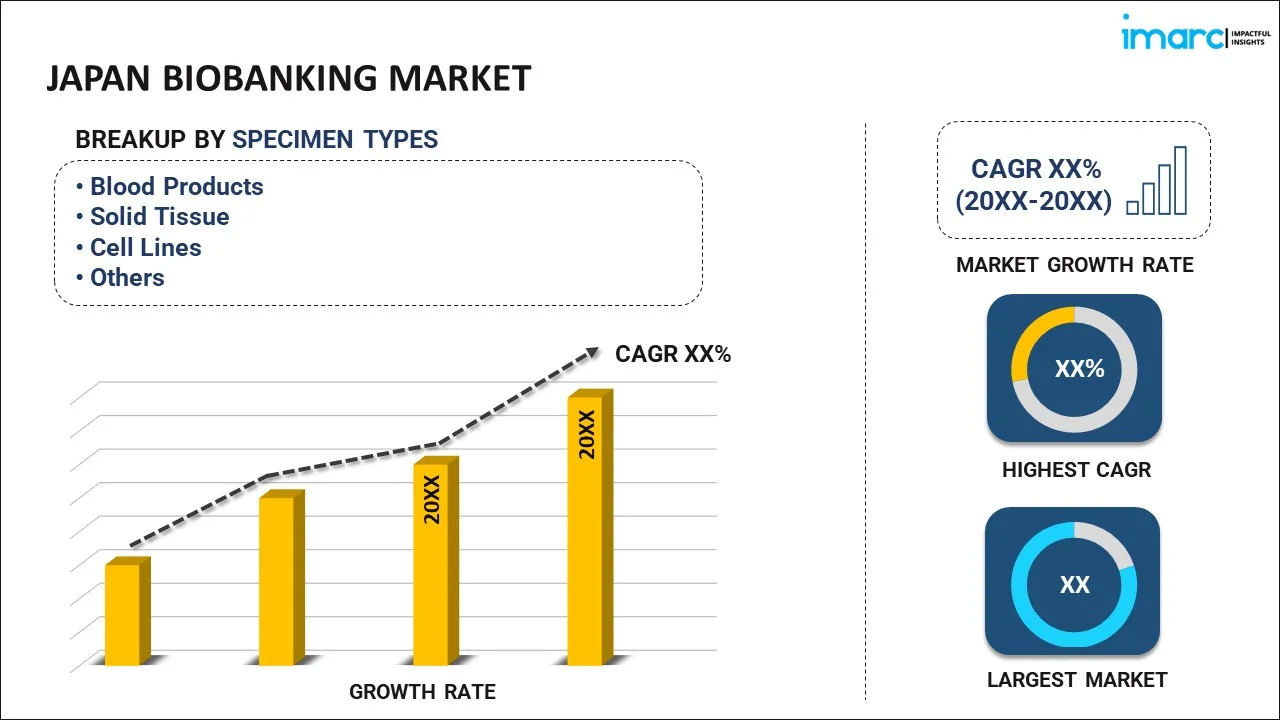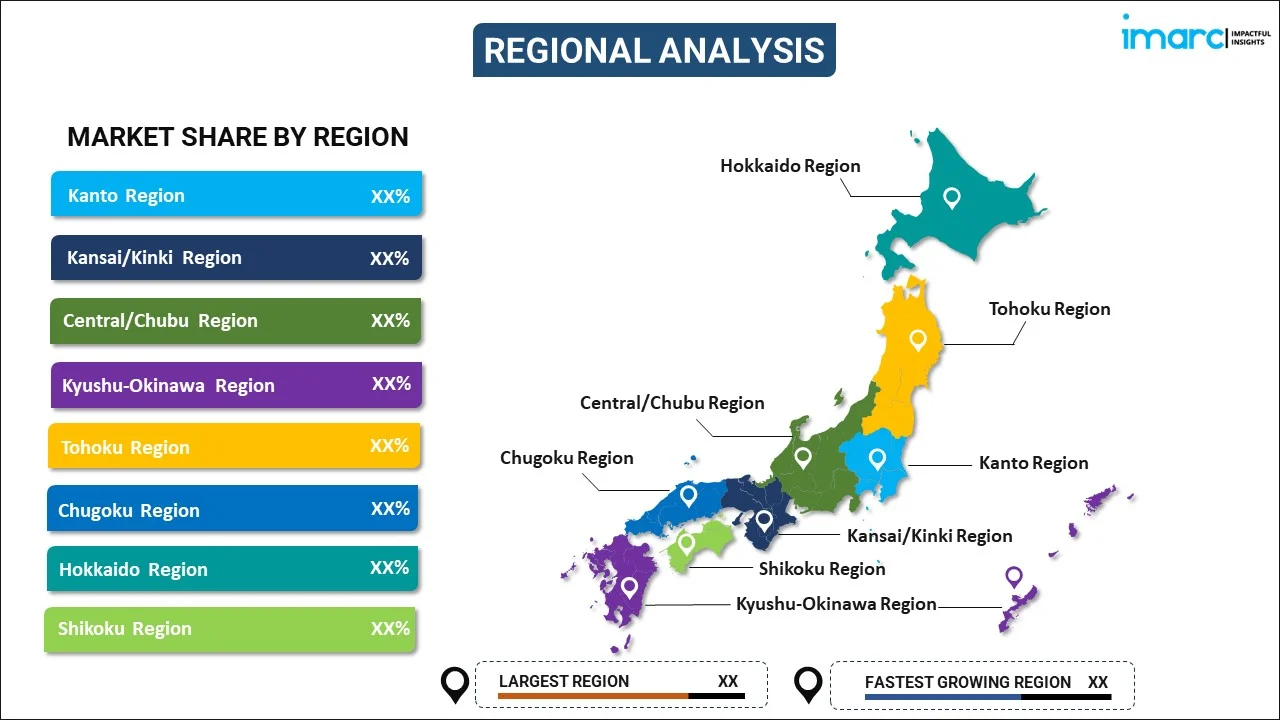
Japan Biobanking Market Report by Specimen Type (Blood Products, Solid Tissue, Cell Lines, Nucleic Acid, and Others), Biobank Type (Population-based Biobanks, Disease-oriented Biobanks), Application (Therapeutics, Research), End User (Academic Institutions, Pharma and Biotech Companies), and Region 2025-2033
Market Overview:
Japan biobanking market size reached USD 3,803 Million in 2024. Looking forward, IMARC Group expects the market to reach USD 5,611 Million by 2033, exhibiting a growth rate (CAGR) of 4.4% during 2025-2033. The increasing demand for personalized medicine, coupled with the growing need for biological samples and data to support research and the development of tailored treatments, is driving the market.
|
Report Attribute
|
Key Statistics
|
|---|---|
|
Base Year
|
2024 |
|
Forecast Years
|
2025-2033
|
|
Historical Years
|
2019-2024
|
| Market Size in 2024 | USD 3,803 Million |
| Market Forecast in 2033 | USD 5,611 Million |
| Market Growth Rate (2025-2033) | 4.4% |
Biobanking is a crucial aspect of modern healthcare and scientific research. It involves the systematic collection, storage, and management of biological samples, such as blood, tissue, and DNA, from individuals for future use in research, diagnostics, and treatment development. Biobanks play a vital role in advancing our understanding of diseases, genetics, and personalized medicine. These repositories preserve specimens and their associated data under strict ethical and regulatory guidelines, ensuring patient privacy and informed consent. Biobanked samples serve as valuable resources for studying diseases, identifying biomarkers, and testing new therapies. They facilitate large-scale, longitudinal studies that can uncover patterns and trends in health and disease over time. Biobanking promotes collaboration among researchers, accelerates medical discoveries, and enhances the potential for tailored treatments based on an individual's genetic makeup. It also supports translational research, bridging the gap between laboratory findings and clinical applications. In summary, biobanking is a critical infrastructure in modern healthcare, advancing medical knowledge and improving patient care.
Japan Biobanking Market Trends:
The biobanking market in Japan is experiencing robust growth due to several key drivers. Firstly, advancements in medical research and the increasing focus on personalized medicine have propelled the demand for biobanking services. These repositories of biological samples enable researchers to access a diverse range of specimens, accelerating their efforts in understanding diseases and developing targeted therapies. Moreover, the growing awareness of the importance of preserving biological materials for future research has prompted both public and private sector investments in biobanking infrastructure. In addition to this, the rising prevalence of chronic diseases, such as cancer and cardiovascular conditions, necessitates extensive biobanking to support the discovery of biomarkers and therapeutic targets. The adoption of genomic medicine and the integration of genetic information into healthcare practices have further amplified the demand for biobanking solutions. Lastly, regulatory initiatives and ethical considerations have strengthened the framework surrounding biobanking, instilling confidence among stakeholders and encouraging their participation. These interconnected drivers are propelling the biobanking market in Japan towards unprecedented growth, promising a future of improved healthcare outcomes and medical breakthroughs.
Japan Biobanking Market Segmentation:
IMARC Group provides an analysis of the key trends in each segment of the market, along with forecasts at the country level for 2025-2033. Our report has categorized the market based on specimen type, biobank type, application, and end user.
Specimen Type Insights:

- Blood Products
- Solid Tissue
- Cell Lines
- Nucleic Acid
- Others
The report has provided a detailed breakup and analysis of the market based on the specimen type. This includes blood products, solid tissue, cell lines, nucleic acid, and others.
Biobank Type Insights:
- Population-based Biobanks
- Disease-oriented Biobanks
A detailed breakup and analysis of the market based on the biobank type have also been provided in the report. This includes population-based biobanks and disease-oriented biobanks.
Application Insights:
- Therapeutics
- Research
The report has provided a detailed breakup and analysis of the market based on the application. This includes therapeutics and research.
End User Insights:
- Academic Institutions
- Pharma and Biotech Companies
A detailed breakup and analysis of the market based on the end user have also been provided in the report. This includes academic institutions and pharma and biotech companies.
Regional Insights:

- Kanto Region
- Kansai/Kinki Region
- Central/ Chubu Region
- Kyushu-Okinawa Region
- Tohoku Region
- Chugoku Region
- Hokkaido Region
- Shikoku Region
The report has also provided a comprehensive analysis of all the major regional markets, which include Kanto Region, Kansai/Kinki Region, Central/ Chubu Region, Kyushu-Okinawa Region, Tohoku Region, Chugoku Region, Hokkaido Region, and Shikoku Region.
Competitive Landscape:
The market research report has also provided a comprehensive analysis of the competitive landscape. Competitive analysis such as market structure, key player positioning, top winning strategies, competitive dashboard, and company evaluation quadrant has been covered in the report. Also, detailed profiles of all major companies have been provided.
Japan Biobanking Market Report Coverage:
| Report Features | Details |
|---|---|
| Base Year of the Analysis | 2024 |
| Historical Period | 2019-2024 |
| Forecast Period | 2025-2033 |
| Units | Million USD |
| Scope of the Report | Exploration of Historical Trends and Market Outlook, Industry Catalysts and Challenges, Segment-Wise Historical and Future Market Assessment:
|
| Specimen Types Covered | Blood Products, Solid Tissue, Cell Lines, Nucleic Acid, Others |
| Biobank Types Covered | Population-based Biobanks, Disease-oriented Biobanks |
| Applications Covered | Therapeutics, Research |
| End Users Covered | Academic Institutions, Pharma and Biotech Companies |
| Regions Covered | Kanto Region, Kansai/Kinki Region, Central/ Chubu Region, Kyushu-Okinawa Region, Tohoku Region, Chugoku Region, Hokkaido Region, Shikoku Region |
| Customization Scope | 10% Free Customization |
| Post-Sale Analyst Support | 10-12 Weeks |
| Delivery Format | PDF and Excel through Email (We can also provide the editable version of the report in PPT/Word format on special request) |
Key Questions Answered in This Report:
- How has the Japan biobanking market performed so far and how will it perform in the coming years?
- What has been the impact of COVID-19 on the Japan biobanking market?
- What is the breakup of the Japan biobanking market on the basis of specimen type?
- What is the breakup of the Japan biobanking market on the basis of biobank type?
- What is the breakup of the Japan biobanking market on the basis of application?
- What is the breakup of the Japan biobanking market on the basis of end user?
- What are the various stages in the value chain of the Japan biobanking market?
- What are the key driving factors and challenges in the Japan biobanking?
- What is the structure of the Japan biobanking market and who are the key players?
- What is the degree of competition in the Japan biobanking market?
Key Benefits for Stakeholders:
- IMARC’s industry report offers a comprehensive quantitative analysis of various market segments, historical and current market trends, market forecasts, and dynamics of the Japan biobanking market from 2019-2033.
- The research report provides the latest information on the market drivers, challenges, and opportunities in the Japan biobanking market.
- Porter's five forces analysis assist stakeholders in assessing the impact of new entrants, competitive rivalry, supplier power, buyer power, and the threat of substitution. It helps stakeholders to analyze the level of competition within the Japan biobanking industry and its attractiveness.
- Competitive landscape allows stakeholders to understand their competitive environment and provides an insight into the current positions of key players in the market.
Need more help?
- Speak to our experienced analysts for insights on the current market scenarios.
- Include additional segments and countries to customize the report as per your requirement.
- Gain an unparalleled competitive advantage in your domain by understanding how to utilize the report and positively impacting your operations and revenue.
- For further assistance, please connect with our analysts.
 Inquire Before Buying
Inquire Before Buying
 Speak to an Analyst
Speak to an Analyst
 Request Brochure
Request Brochure
 Request Customization
Request Customization




.webp)




.webp)












